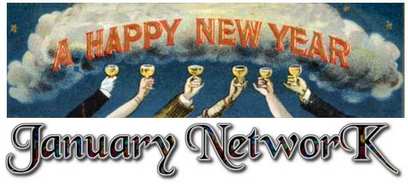NetworK ezine Issue 20. January 2017
It’s New Year. Let’s Celebrate ... Let’s Dance!
How about a tango? Tempestuous and controversial, the tango set tongues wagging from its inception in the 1890s, as it swept the world. Doctors denounced it, German military officers were dismissed for dancing it, Queen Mary disapproved of it and the Archbishop of Paris banned it.
Others, of course, loved it. In 1914 one lady had a “tangometer” attached to her ankle, proving that she covered 25,000 miles in tango dancing at society gatherings! The more it caused sensation and notoriety, the more popular it became.
But did you know that the tango is commemorated and celebrated in Carnival Glass? It became a firm favourite in Finland and even today the tango has its own annual festival there. A magnificent ashtray was made by Karhula in the early 1930s – here it is in blue Carnival Glass.
How about a tango? Tempestuous and controversial, the tango set tongues wagging from its inception in the 1890s, as it swept the world. Doctors denounced it, German military officers were dismissed for dancing it, Queen Mary disapproved of it and the Archbishop of Paris banned it.
Others, of course, loved it. In 1914 one lady had a “tangometer” attached to her ankle, proving that she covered 25,000 miles in tango dancing at society gatherings! The more it caused sensation and notoriety, the more popular it became.
But did you know that the tango is commemorated and celebrated in Carnival Glass? It became a firm favourite in Finland and even today the tango has its own annual festival there. A magnificent ashtray was made by Karhula in the early 1930s – here it is in blue Carnival Glass.
Read more about the ashtray and see the catalogue illustrations as well as the actual mould that was used to make it - click here: Collectors Facts or click on the picture above.
|
“Light in Colour and Entirely Different”
In December 1911, when Harry Northwood was asked if the craze for the “new” iridescent glass was over, how do you think he responded? This fascinating extract from the December 1911 “Pottery and Glass Salesman” gave the answer to what Harry was about to launch onto the market - what collectors refer to today as Northwood's "ice colours". How was the glass made? Acid treatment (usually using hydrofluoric acid) caused the ice or frosted effect on the surface of the glass, sometimes felt as a kind of roughness (though there are also examples that have a smooth feel). Colours with this finish are often called ice colours or pastels. Ice green, ice blue and white are the main Northwood examples of acid treated colours. The acid treatment was carried out prior to iridising with a pastel iridescence that enhanced the frosty effect. Below, left: a splendid ice blue Good Luck bowl from Northwood (picture courtesy of Seeck Auctions). The pattern echoes our sentiments for the Season: we wish you Good Luck for the New Year. Below right: Tornado vases in ice colours! Ice blue on the left (photo courtesy Seeck Auctions) and the rare ice green on the right (photo copyright Stephen Thistlewood). |
Chasing the Rainbow
|
Its mercurial brilliance dazzles. Turn it this way and that, capturing the iridescence and the light as it moves. It’s like chasing a rainbow; there one moment, gone the next. These beautiful vases were made in the Czech Republic c. 1960s and 1970s – the iridised versions are not easy to find. They’re unusual too, in that their designers are known and revered. The Brick vases illustrated on the right were designed by Jiri Zejmon and they were made at Rudolfova Hut (previously made famous by Josef Inwald). Read The Story Behind The Glass: Sklo Union Iridescent Vases |
Search and Ye Shall Find
Our Carnival Glass Worldwide website is packed full of information, features, illustration and articles, and it is now even easier for you to find what you are looking for.
There is a very powerful search tool, that searches everything on the website (just like a Google search). It's on every page, in the top right corner. Just enter a few key words into the "Search" box (shown in the illustration below) and hit the magnifying glass symbol.
There is also a comprehensive Pattern Index which has something approaching 2000 patterns referenced. Click here: Pattern Index.
Why not join our NetworK Facebook Group? Share pictures, stories, comments, and friendly repartee in this very active Group - it's a fun place to "meet and greet" all your Carnival Glass friends: Carnival Glass NetworK









